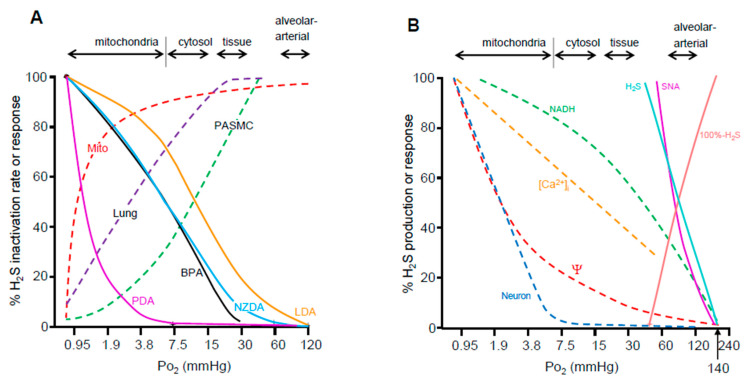Figure 4.
(A) Oxygen sensitivity of putative O2-sensing systems as a function of approximate range of oxygen tension (Po2) in blood, tissues, and intracellular compartments (arrows). These are compared to O2 sensitivity of H2S oxidation (inactivation) by homogenized bovine lung (Lung), pulmonary arterial smooth muscle cells (PASMC) and bovine heart mitochondria (Mito) indicated by dashed lines. Solid colored lines show physiological responses (hypoxic vasoconstriction) of bovine pulmonary arteries (BPA), lamprey dorsal aorta (LDA), and dorsal aortas from New Zealand and Pacific hagfish (NZDA and PDA, respectively) as a function of Po2. The H2S oxidation and O2 sensitivity of tissue H2S consumption is similar to O2 sensitivity in vessels from oxygen sensitive vertebrates (bovine, lamprey and New Zealand hagfish), whereas O2 sensitivity in Pacific hagfish aortas is considerably lower commensurate with their tolerance to hypoxia. The Po2 values at which H2S metabolism is impaired are at the low end of cytosolic and mitochondrial Po2s and would be expected during hypoxia. It is evident that the efficacy of H2S oxidation mechanisms correlates well with physiological responses. (B) Comparison of the O2 sensitivity of afferent sinus nerve activity from the carotid body (SNA) to H2S production (H2S; or its calculated inverse, 100%-H2S) and components of intracellular signaling in the carotid body (solid lines). The Po2 of the half-maximal response (P50) for activation of the carotid is essentially identical to the P50 for H2S production which is more evident when the latter is expressed as the inverse (100%-H2S). The P50 for intracellular excitation events such as, mitochondrial NADH, intracellular calcium ([Ca2+]I), mitochondrial transmembrane potential (Ψ) or activation of sympathetic neurons (Neuron; dashed lines) are well below the P50s of the intact carotid body or H2S production. (A) Adapted from [10,88], with permission. (B) Adapted from [86], with permission and drawn from data in [87]. Reproduced with permission from Kenneth R. Olson et al. [10]. Reproduced with permission from Kenneth R. Olson et al. [88].

